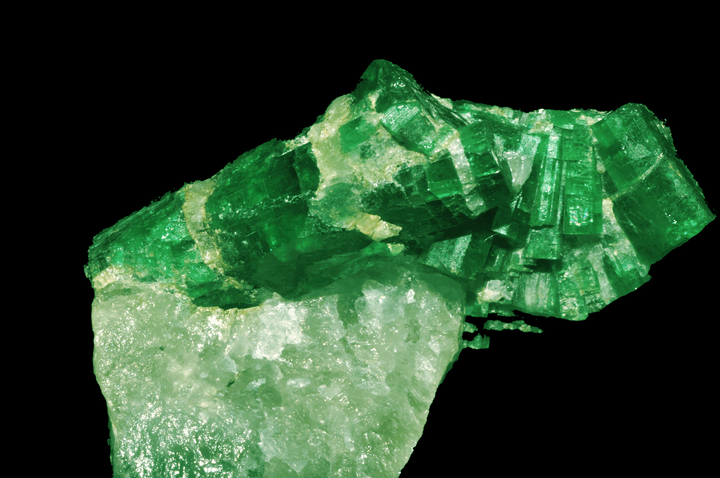Brazil’s Green Light
– Carlo Massimo
Emerald mining is dangerous, dirty, unforgiving work. And it’s going full tilt in the town of Carnaíba.
The scene in Carnaíba, in the Brazilian state of Pernambuco, is bleak. Skull and crossbones signs, meant to warn passersby of explosives, grin down on huge expanses of black rocks, mostly the size of street cobbles. The forest sprawls muddily in the distance; on this side of the power lines, everything is dirty concrete, thatched roof, and endless black rock. A dog, curled beneath the bright green wall of a shack, is picking at its open sores and ignoring a cloud of flies. These are the gemstone mines of Pernambuco, where, more often than anywhere else in the world, rich veins of emerald reveal themselves in the rock, making miners into millionaires overnight.
In a piece for Narratively, video-journalists Giulia Valentina Paolini and Bruno Pitzalis explored the unrelenting hunt for emerald in this small, soot-black mining town. The work of a garimpeiro, or prospector, is unforgiving, the chances of finding emeralds scant. But in Carnaíba, there seems to be no shortage of labor.
Mining has always been a pillar of the Brazilian economy. Beginning in the 1690s, prospectors poured into various corners of Brazil, tempted by reports of tremendous gold and diamond deposits. The profits from precious stones and metals funded all of Brazil’s nascent industries, and the influx of Portuguese prospectors and African slaves swelled the national population from three hundred thousand people to three million over the course of the 18th century.
In the 21st century, Brazil’s mining industry is seeing a new surge of expansion. According to a 2012 report by IBRAM, a business network for Brazil’s mining companies, mineral production in Brazil exploded in 2010. International recession be damned: 2010 almost doubled 2009’s output, and production rates have been climbing steadily ever since. The minerals in question include tin, iron ore, bauxite, and manganese, all in high demand for modern industry — especially in emerging economies, as the IBRAM report points out. Brazil, Russia, India, and China (known collectively as the BRICs) are urbanizing rapidly and leaning heavily on their technological and industrial sectors. Those sectors need tin and bauxite and niobium, all of which emerge daily out of mines in Minas Gerais, Pernambuco, and elsewhere.
But the rising economies of the BRICs do not seem to explain the fortunes of Noel, who struck an invaluable emerald lode in Carnaíba in 1999. Certainly it didn’t come easily for him. “You need to work hard,” he says. “Lots of pain.” He wears a large gold wristwatch and displays a substantial belly; a gold necklace drips from his open collar, and on his left hand is a ring fitted with an enormous emerald. The camera zooms in admiringly several times.
Outside, the prospectors, aspiring Noels all, are hard at work. Deep in a mineshaft, a prospector named Edson tells the camera that he’s been digging emeralds for twenty years. “I got used to it,” he says. His family lives in faraway Belo Horizonte, capital of the state whose name means “General Mines.” He doesn’t want his children to prospect: “Everybody knows, garimpeiros are poor men.” In the background, a half-naked man pounds with a chisel by the dim light of a lantern.
Up above, in the field of black cobbles, a woman named Lise washes stones in a sieve. She works in a house dress, barefoot; she’s not yet found the emerald that will make her rich. Leandro, a man of fifty or sixty, holds fragments of emerald up to the camera in a green plastic bag. “I’ve not been kissed by fortune yet,” he says, “but my day will come.”
Emeralds have little industrial value, especially relative to Brazil’s other minerals. Their value, in many ways, is more symbolic. Paolini and Pitazlis’ short documentary abounds with the color green, a strange, bright, vaguely unnatural green. Green lights shine over the workbenches where the gems get processed. Leandro’s plastic bag is green. The sick dog leans against a green wall. It’s the color of emerald, but it’s also the color of Gatsby’s unending optimism, and it has the spooky, robotic quality of cell-phone light.
The promise of Brazil, like the other BRIC countries, has always been problematic; its meteoric rise, which once depended on slavery, now brings with it a host of the 21st century’s worst social problems: a staggering environmental footprint, widespread corruption, human rights abuses, and enormous social inequality. These problems are not unique to Brazil. They are the characteristic problems of all the BRICs, where GDP is soaring and smart phones are flying off the shelves.
The promise of the emeralds, squalid and irresistible, is the promise of the 21st century.
* * *
Source: Giulia Valentina Paolini and Bruno Pitzalis. “The Great Green Rush,” Narratively, 2015.
Cover photo courtesy of Parent Géry
